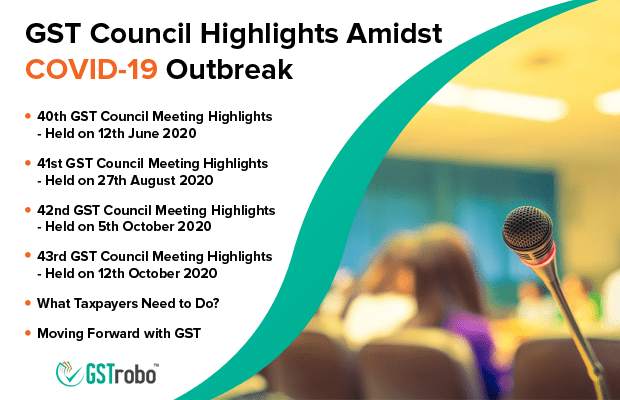GST Council Highlights Amidst COVID-19 Outbreak
The Hon’ble Union Finance Minister announced several relief measures in the GST council meets to cater to the needs of taxpayers amidst the COVID-19 outbreak.

40th GST Council Meeting Highlights – Held on 12th June 2020
- The government additionally gave some relief to small taxpayers with nil liability by eliminating the late charge for GSTR 3B documenting. Be that as it may, returns with liability will pull in INR 500 as the maximum late fee for the taxpayers who file their returns between 1st July 2020 and 30th September 2020.
- MSME filers: For small taxpayers having turnover up to INR 5 crores, the rate of interest for documenting the GST returns with delay for the period of Feb, Mar and April 2020, past July 6, 2020, has been decreased to 9%, which was 18% prior.
- Small taxpayers having turnover up to INR 5 crores will be not accused of any late expense or interest if they effectively file GSTR-3B for the month of May, June, and July, August, and September 2020.
41st GST Council Meeting Highlights – Held on 27th August 2020
The states have been provided with two options to meet the revenue shortfall amid COVID-19 pandemic.
- The government concurs that this isn’t the ideal opportunity to talk about tax rates.
- To meet the shortfall of compensation cess the states have been provided with two options:
- The Central government can provide INR 97,000 crore to states as borrowings via RBI that can be paid with a reasonable rate of interest after 5 years on the collection of CESS, or
- The states can borrow INR 2,35,000 Crores directly from the RBI.
- The state has to opt from the given options within seven working days as the GST Council will have to finalize the choices.
- The Ministry also suggested that they will discuss with RBI to help states to get funds at the rate of G-Security linked rates.
42nd GST Council Meeting Highlights – Held on 5th October 2020
- GSTR1 and GSTR3B which is to be recorded quarterly by the taxpayers whose turnover does not exceed INR 5 crores from 1st January 2021, despite the fact that the payment has to be made on the 13th of the month succeeding the quarter; using challan. The number of returns has been reduced from 24 to 8.
- Effective 1st April 2021 –For the taxpayers whose annual turnover is more than INR 5 Crores, HSN should contain a 6-digits code while for the taxpayers whose annual turnover is less than INR 5 Crores, HSN should contain a 4-digits code.
- From 1st January 2021, the refund will be provided to those whose bank account is updated with PAN and AADHAR. However, the refund application can be signed via AADHAR Card OTP.
- Tax liabilities will get auto-filled from taxpayers’ own GSTR-1 with effect from 1st January 2021.
- Council also recommended furnishing Nil FORM CMP-08 via SMS.
- The existing GSTR-1 and GSTR-3B facility will be extended up to 31st March 2021.
43rd GST Council Meeting Highlights – Held on 12th October 2020
- A 50-year old interest loan of INR 1,600 crore for the North-Eastern states and INR 900 crore for such loans for Himachal Pradesh and Uttarakhand reported. The sum should be spent by March 31, 2021.
- Other states will likewise get a loan of INR 7,500 crore in Finance Commission development.
- FM Sitharaman prior said that regardless of whether the states don’t pick both of the two loaning choices, the Center will figure out how to furnish them with a compensation levy.
- The Centre also issued a borrowing calendar, and The G-Security deals used as a benchmark for every other borrowing will go up if it goes beyond it. Which will eventually increase the borrowing costs for states and the private sectors.
What Taxpayers Need to Do?
While there is a ton that the Government needs to do to encourage a proficient tax management system, the taxpayers likewise need to do their bit and add to the development of the Goods and Services Tax. This incorporates:
- Filing GST returns on time because as per the statistics every 5th registered taxpayer will wait until the last day of the deadline to file his/her return.
- Every taxpayer needs to adopt and adapt GST changes like e-invoicing, e-wallet, QR codes, and utilization of AI to calculate tax liabilities.
- Taxpayers need to put resources into tax management software and automate their GST compliance but for this, they need to choose a technology partner with extensive experience in tax management systems such as GSTrobo®.
Moving Forward with GST
- India needs to focus on faster refunds disbursal, dispute redressal, and reconciliation resolution.
- A brilliant opportunity before India to fulfill the gap left by China to become a global leader in the manufacturing and supply chain hub.
